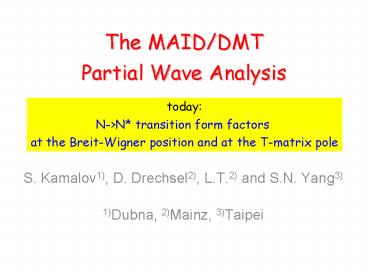The MAIDDMT Partial Wave Analysis - PowerPoint PPT Presentation
1 / 32
Title:
The MAIDDMT Partial Wave Analysis
Description:
The MAID/DMT. Partial Wave Analysis. S. ... In N* physics, the existence of a resonance, its position ... F15, F17, F35, F37. MAID unitarization procedure ... – PowerPoint PPT presentation
Number of Views:109
Avg rating:3.0/5.0
Title: The MAIDDMT Partial Wave Analysis
1
The MAID/DMT Partial Wave Analysis
today N-gtN transition form factors at the
Breit-Wigner position and at the T-matrix pole
- S. Kamalov1), D. Drechsel2), L.T.2) and S.N.
Yang3) - 1)Dubna, 2)Mainz, 3)Taipei
2
N -gt N Transition Form Factors
- In N physics, the existence of a resonance, its
position and quantum numbers are the primary
goal.This can be reached with different probes. - But the electromagnetic probe tells us about the
structure, how a resonance is built from
constituents. - This structure information can be obtained from
the transition form factors. - These form factors cannot be directly measured,
but are obtained in partial wave analysis of
meson electroproduction.
3
(No Transcript)
4
Inclusive Cross Section for Real and Virtual
Photo Absorption
5
Inelastic Electron Scattering in the Resonance
Region
6
(No Transcript)
7
- in general
- transition form factors can only be obtained by
- partial wave analysis
- and background / resonance separation
8
dynamical approach to pion electroproduction
K-matrix Born approximation
9
MAID unitarization procedure
K-matrix unitarization for all background partial
waves up to L3 S11, S31 P11, P13, P31, P33
D13, D15, D33, D35 F15, F17, F35, F37
10
MAID unitarization procedure
a correction phase f(W) for all Breit-Wigner
resonance contributions S11 S31 P11 P13
P31 P33 D13 D15 D33 D35 F15 F17 F35
F37
13 nucleon resonances are included in MAID,
7 N 5 D
11
in the MAID Ansatz, the fit parameters are
already the reduced multipoles, that are needed
to determine the photon couplings and the
transition form factors
12
Definition of the N-N Form Factors
reduced multipoles
different sets of form factors can be defined as
linear combinations of the reduced multipoles
helicity amplitudes
Sachs form factors
covariant (Dirac) form factors
for spin ½ resonances as Roper P11 or S11 we get
only 2 ff
13
partial wave analysis
with resonance and background separation
for helicity amplitudes and transition form
factors we need the imaginary parts of the
resonance multipoles
14
due to Watsons theorem, the background is zero
at the D(1232) position
15
(No Transcript)
16
N N Transition Form Factors
17
Results for the dominant resonances of the proton
?
?
?
?
?
?
?
?
?
?
?
?
?
for isospin ½ resonances also neutron form
factors have been analyzed, but the results are
very uncertain, no data after 1988
18
(No Transcript)
19
transition form factors of the Roper
comparison of MAID and JLab analysis
A1/2
MAID analysis 2007/08
JLab analysis 2008
S1/2
20
(No Transcript)
21
N-Delta and N-Roper Transition Form Factors on
the Lattice
Huey-Wen Lin et al., 2008
C. Alexandrou et al., 2008
N-Roper quenched with mp720 MeV
N-Delta unquenched with mp360 MeV
F1
GM
F2
pion cloud problem at small Q²
22
N -gt S11(1535)
MAID analysis 2007/2008
JLab analysis 2008
longitudinal S1/2
transverse A1/2
23
from Breit-Wigner positions
to T-matrix pole positions
24
Physics Letters B 385 (1996) 45
residues
phases
25
Physical Review C 59 (1999) 1810
26
(No Transcript)
27
(No Transcript)
28
(No Transcript)
29
(No Transcript)
30
(No Transcript)
31
(No Transcript)
32
Summary and Conclusions
recent results from pN channel (Maid2007/08)
N-gtN transition form factors for 13 N/D
resonances with PDG
rating reasonably well for I3/2 P33(1232)
I1/2 proton P11(1440), S11(1535),
D13(1520), F15(1680)
S11(1650), D15(1675), P13(1720) also global
fits for S31(1620), D33(1700), I1/2 neutron
for most of these states global fits exist
for the first time we have calculated transition
form factors at the T-matrix pole preliminary
result the complex phase seems to be constant
over a large Q² range
next step new dynamical model for pion
electroproduction DMT2009































